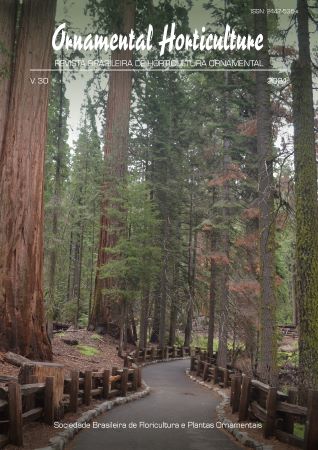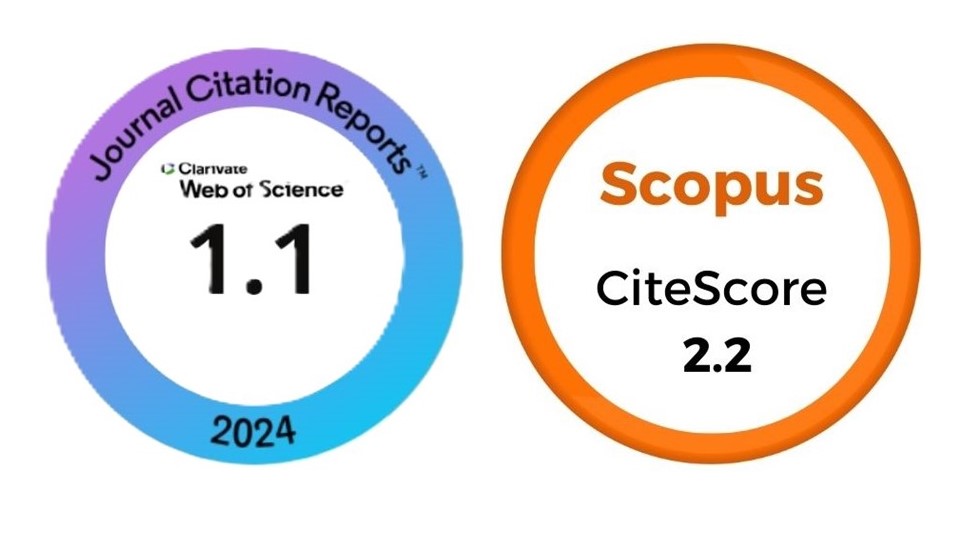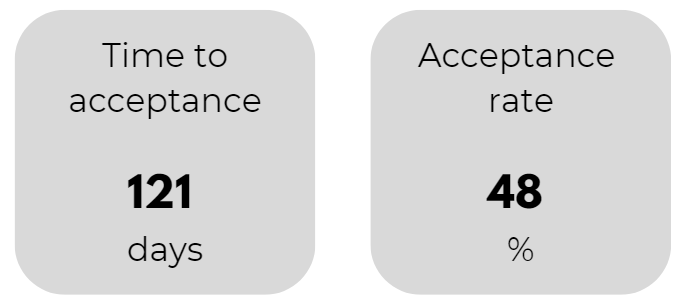A poda pode aumentar o efeito alelopático? Um estudo com pingo-de-ouro
DOI:
https://doi.org/10.1590/2447-536X.v30.e242705Palavras-chave:
bioensaio, Duranta erecta, índice de efeito alelopático, Lactuca sativa, plantas ornamentaisResumo
Pingo-de-ouro (Duranta erecta L.), conhecida por suas aplicações paisagísticas, é frequentemente submetida a sucessivas podas para manter sua estrutura ornamental, sabendo-se que essa prática gera inúmeras respostas fisiológicas e químicas na planta. Portanto, este estudo teve como objetivo avaliar a influência da poda e de diferentes métodos de extração sobre o potencial alelopático da Pingo-de-ouro na germinação e crescimento inicial da alface. Os extratos das folhas foram obtidos por decocção (quente) e maceração (frio) em concentrações de 20%, 40%, 60%, 80% e 100%, tendo água destilada como controle negativo. Foi realizada a triagem fitoquímica dos extratos para identificar compostos fenólicos, flavonoides, antocianidinas, taninos, heterosídeos cardiotônicos, saponinas, alcaloides e terpenos. Para o bioensaio, foram mensurados e caracterizados parâmetros germinativos e morfológicos. Os dados foram submetidos à análise de variância (ANOVA) e, para os dados quantitativos, foram ajustados modelos de regressão, enquanto para os dados qualitativos, as médias foram comparadas pelo teste de Scott-Knott com 5% de significância. Foram observadas diferenças significativas entre os métodos de extração e as práticas de manejo, sendo que o extrato aquoso quente das plantas podadas reduziu significativamente a germinação em concentrações mais elevadas. O crescimento inicial da alface foi gravemente prejudicado, apresentando inúmeras anormalidades morfológicas, com danos severos ao sistema radicular em todas as concentrações. Este estudo sugere que as práticas de poda têm um efeito modulador na atividade alelopática da Pingo-de-ouro, fornecendo informações valiosas para projetos paisagísticos e estudos botânicos, considerando sua avaliação e produção de fitoquímicos fitotóxicos.
Downloads
Referências
AHMED, W.S.; MOHAMED, M.A.; EL-DIB, R.A.; HAMED, M.M.New triterpene saponins from Duranta repens Linn, and their cytotoxic activity. Molecules, v.14, n.5, p.1952-1965, 2009. https://doi.org/10.3390/molecules14051952
AMÂNCIO, B.C.S.; GOVÊA, K.P.; TRINDADE, L.O.R.; CUNHA NETO, A.R.; SOUZA, T.C.; BARBOSA, S.; NETO, A.R.C.; TRINDADE, L.O.R.; SOUZA, T.C.; SILVA, G.A.; BARBOSA, S. Allelopathic activity of different Byrsonima spp.leaf extracts on Lactuca sativa L. bioassay. Biologia, v.76, n.11, p.3201-3209, 2021. https://doi.org/10.1007/s11756-021-00872-0
BRASIL. Farmacopeia Brasileira. 6ed. Brasilia: Agência Nacional de Vigilância Sanitária, 2019.958p.
BRICCHI, I.; LEITNER, M.; FOTI, M.; MITHÖFER, A.; BOLAND, W.; MAFFEI, M.E. Robotic mechanical wounding (MecWorm) versus herbivore-induced responses: early signaling and volatile emission in Lima bean (Phaseolus lunatus L.). Planta, v.232, n.3, p.719-729, 2010. https://doi.org/10.1007/S00425-010-1203-0
CALVELLI, J.V.B.; BETELLI, V.M.; BRAGA, D.V.B.; BASTOS, R.G.; CUNHA NETO, A.R.; VILEGAS, W.; SILVA, M.J.D.; SILVA, M.A.; SILVA, G.A.; BARBOSA, S. Phytochemical characterization and bioherbicide potential of Duranta erecta L. Alellopathy Journal, v.60, n.2, p.123-136, 2023. https://doi.org/10.26651/allelo.j/2023-60-2-1458
CARDOSO, C.M Z. Manual de controle de qualidade de matérias-primas vegetais para farmácia magistral. São Paulo: Pharmabooks, 2009.148p.
CUNHA NETO, A.R.; SILVA, I.G.; CALVELLI, J.V.B.; MARTINS, G.E.C.; CARVALHO, M.; BARBOSA, S. Toxicity of heavy metals that affect germination, development and cell cycle of Allium cepa L. Bulletin of Environmental Contamination and Toxicology, v.111, n.2, p.1-7, 2023. https://doi.org/10.1007/s00128-023-03775-9
FERREIRA, D.F. SISVAR: A computer analysis system to fixed effects split plot type designs. Brazilian Journal of Biometrics, v.37, n.4, p.529535, 2019. https://doi.org/10.28951/RBB.V37I4.450
GOVÊA, K.P.; PEREIRA, R.S.T.; ASSIS, M.D.O.; ALVES, P.I.; BRANCAGLION, G.A.; TOYOTA, A.E.; MACHADO, J.V.C.; CARVALHO, D.T.; SOUZA, T.C.; BEIJO, L.A.; TRINDADE, L.O.R.; BARBOSA, S. Allelochemical activity of eugenol-derived coumarins on Lactuca sativa L. Plants, v.9, n.4, p.533, 2020. https://doi.org/10.3390/plants9040533
HARTLEY, S.E.; FIRN, R.D.Phenolic biosynthesis, leaf damage, and insect herbivory in birch (Betula pendula). Journal of Chemical Ecology, v.15, n.1, p.275-283, 1989. https://doi.org/10.1007/BF02027789
HIRADATE, S.; YADA, H.; ISHII, T.; NAKAJIMA, N.; OHNISHI-KAMEYAMA, M.; SUGIE, H.; ZUNGSONTIPORN, S.; FUJII, Y. Three plant growth inhibiting saponins from Duranta repens. Phytochemistry, v.52, n.7, p.1223–1228, 1999. https://doi.org/10.1016/S0031-9422(99)00408-2
JIN, M.R.; WANG, Z.; HE, Z.S.; JIANG, -; LIU, J.F.; LAN; SHI, Y.W.; SHEN, C.X. Allelopathic effect of castanopsis kawakamii forest litter on seed germination of small philippine acacia (Acacia confusa). Applied Ecology and Environmental Research, v.17, n.6, p.15103-15116, 2019. https://doi.org/10.15666/aeer/1706_1510315116
KHANAL, P.; PATIL, B.M. Duranta repens Linn reverses hepatic and peripheral insulin resistance in fructose-induced hyperinsulinaemic rats – Experimental and computational findings. South African Journal of Botany, v.148, p.469-481, 2022. https://doi.org/10.1016/j.sajb.2022.05.011
KONG, C.; HU, F.E.I.; XU, X. Allelopathic potential and chemical constituents of volatiles from Ageratum conyzoides under stress. Journal of Chemical Ecology, v.28, n.6, p.1173-1182, 2002.
KRUIDHOF, H.M.; VAN DAM, N.M.; RITZ, C.; LOTZ, L.A.P.; KROPFF, M.J.; BASTIAANS, L. Mechanical wounding under field conditions: A potential tool to increase the allelopathic inhibitory effect of cover crops on weeds? European Journal of Agronomy, v.52, p.229-236, 2014. https://doi.org/10.1016/j.eja.2013.09.003
KUMAR, M.; GARKOTI, S.C. Allelopathy effects of invasive alien Ageratina adenophora on native shrub species of chir pine forest in the central Himalaya, India. Journal of Forest Research, v.27, n.1, p.53- 62, 2022. https://doi.org/10.1080/13416979.2021.2002505
LOPES, A.D.; NUNES, M.G.I.F.; FRANCISCO, J.P.; SANTOS, E.H. Potential allelopathic effect of species of the asteraceae family and its use in agriculture. In: EL-ESAWI, M.A. Asteraceae - Characterization, Recent Advances and Applications. London: IntechOpen, 2022. p.29.
MRID, R.B.; BENMRID, B.; HAFSA, J.; BOUKCIM, H.; SOBEH, M.; YASRI, A. Secondary metabolites as biostimulant and bioprotectant agents: A review. Science of the Total Environment, v.777, p.146204, 2021. https://doi.org/10.1016/J.SCITOTENV.2021.146204
NAKADA-FREITAS, P.G.; POSTINGUEL, L.M.; BERNARDO, M.P.; BONINI, C.S.B.; SANTOS, J.T.; RODRIGUES, C.S.; HIDALGO, G.F.; HEINRICHS, R.; LANNA, N.B.L.; NETO, A.B.; SANTOS, M.A.; MATOS, A.M.S. Conduction and pruning systems in mini watermelon ‘Sugar Baby’. Research, Society and Development, v.10, n.1, p.e34910111793, 2021. https://doi.org/10.33448/RSD-V10I1.11793
NOGUEIRA, M.L.; CAMPOS, N.A.; SANTOS, S.C.; BEIJO, L.A.; BARBOSA, S. The species used in urban afforestation can present phytotoxicity-a case of study of Schinus molle. Ciencia Florestal, v.31, n.1, p.66-84, 2021. https://doi.org/10.5902/1980509820597
PALANIVEL, H.; TILAYE, G.; BELLIATHAN, S.K.; BENOR, S.; ABERA, S.; KAMARAJ, M. Allelochemicals as natural herbicides for sustainable agriculture to promote a cleaner environment. In: ARAVIND, J. Strategies and Tools for Pollutant Mitigation.[s.l.]. New York City: Springer International Publishing, 2021. p.93-116.
PINTO, G.; KOLB, R. Seasonality affects phytotoxic potential of five native species of Neotropical savanna. Botany, v.94, n.2, p.81-89, 2015. https://doi.org/https://doi.org/10.1139/cjb-2015-0124
SHARMA, G.; MALTHANKAR, P.A.; MATHUR, V. Insect-plant interactions: a multilayered relationship. Annals of the Entomological Society of America, v.114, n.1, p.1-16, 2021. https://doi.org/10.1093/AESA/SAAA032
SILVA, V.B.; BEZERRA, J.W.A.; CRUZ, M.F.; LEANDRO, C.S.; SOUSA, J.F.O.; SANTOS, M.A.F.; SANTOS, A.C.B.; COSTA, N.C.; CAMPOS, N.B.; CORDEIRO, L.S.; COSTA, J.G.M.; SILVA, M.A.P. Allelopathy of Dahlstedtia araripensis on Calotropis procera and Zea mays. Journal of Agricultural Science, v.11, n.14, p.32, 2019. https://doi.org/10.5539/JAS.V11N14P32
SONG, W.; FENG, Q.; ZHANG, Y.; WU, X.; SHI, C.; WANG, S.The complete chloroplast genome sequence of Duranta erecta (Verbenaceae). Mitochondrial DNA Part B: Resources, v.6, n.7, p.1832-1833, 2021. https://doi.org/10.1080/23802359.2021.1934164
SRIVASTAVA, M.; SHANKER, K. Duranta erecta Linn: A critical review on phytochemistry, traditional uses, pharmacology, and toxicity from phytopharmaceutical perspective. Journal of Ethnopharmacology, v.293, p.115274, 2022. https://doi.org/10.1016/J.JEP.2022.115274
TUR, C.M.; BORELLA, J.; PASTORINI, L.H. Alelopatia de extratos aquosos de Duranta repens sobre a germinação e o crescimento inicial de Lactuca sativa e Lycopersicum esculentum. Biotemas, v.27, n.3, p.23-32, 2010. https://doi.org/10.5007/2175-7925.2010v23n2p13
WANG, L.; LIU, Y.; ZHU, X.; ZHANG, Z.; HUANG, X. Identify potential allelochemicals from Humulus scandens (Lour.) Merr.root extracts that induce allelopathy on Alternanthera philoxeroides (Mart.) Griseb. Scientific Reports, v.11, n.1, p.1-8, 2021. https://doi.org/10.1038/s41598-021-86656-7
YU, Y.; ZHONG, S.; XU, Z.; XU, Z.; WANG, C.; DU, D. Does the salt stress intensify the independent allelopathy and the co-allelopathy of Solidago canadensis L. and Conyza canadensis (L.) Cronq.? South African Journal of Botany, v.153, p.37-45, 2023. https://doi.org/10.1016/J.SAJB.2022.12.015
Downloads
Publicado
Edição
Seção
Licença
Copyright (c) 2024 Ornamental Horticulture

Este trabalho está licenciado sob uma licença Creative Commons Attribution 4.0 International License.








